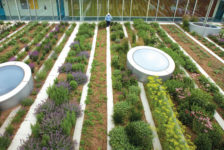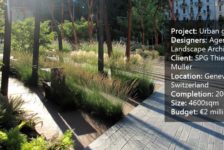Article by Emily Sinclair – We take a look at the all important landscape architecture CV, looking at 10 things you should definitely include if you are serious about getting a position in your chosen company. So you have started the job hunting process, you have prepared a portfolio, created a list of dream jobs and have begun approaching firms, you are well on your way to a successful career as a landscape architect. Then you get a request for a CV. Where do you start?
CV vs Resume
The first step is to realize that a CV and a resume are two different documents with different purposes. A resume is a brief outline of your experience and abilities. A CV is a more in-depth, and at times lengthy, account of your background and achievements as they relate to your prospective job. When building your landscape architecture CV, remember that you are in a design profession. The graphic layout of your CV is extremely important, as when applying to a design profession your CV will be reviewed by someone with an eye for design. Make sure that the design of your CV is uncluttered and easy to follow.
Landscape Architecture CV
Below we have compiled a list of ten must-have points to include on your CV. 10. Contact Information This does sound like a no-brainer, yet people overlook it. This is important; without your name and phone number the prospective employer will have no way to contact you. It is also a good idea to include your email and website/blog if you have one. Keep in mind though – email addresses should be professional-sounding. If you do not already have an email that is simple and respectable then consider starting a new account before printing your landscape architecture CV for distribution.
9. Cultural Experiences
Whether you have travelled for school, for fun, or for work, consider how your experiences abroad have taught you about not only landscape architecture projects but also adaptability and sensitivity to changing environments. Include the duration of the trip, the nature of your travels and what you completed during and as a result of your experiences.

Get some traveling done and be a person of the world. Image: Webb Bridge, Docklands, Melbourne, Australia,; credit: shutterstock.com
8. Scholarly Grants, Scholarships, and Awards
Scholarships can do so much more than help take the edge off of tuition. Think about what this says about your character, even without seeing your application; a prospective employer can assume that some character trait you possess was seen as exemplary by the people executing the award. They will also see someone who is interested in putting in some extra work to achieve their goals. Include the year you were awarded, the amount of the scholarship, and the name of the sponsor.
7. Related Extracurricular Activities
This is where many students can shine, all the volunteer work and extra hours helping teachers or community members can be boasted here. Include any work on student council, participating in local events or volunteering in the arts community. Anything that demonstrates your willingness to further your professional development outside of school can be mentioned here. Include dates of involvement and a short one-sentence summary on what the position entailed.

Getting involved in activities such as this one can really help your cause. Image: 72 Hours Urban Action is an international rapid architecture event, check it out HERE! and get involved credit: Mor Arkadir
6. Papers, Books, and Other Publications
Having your work in a gallery or publication means someone appreciated and enjoyed your work. This says a lot about what you can potentially produce, even if the prospective employer has not seen the exhibition or book. It’s worth noting in this section if the exhibit or work was invited or juried. If the publication or exhibition is solely yours, make sure to note that, and any reviews or citations that the work/s have accumulated.
5. Professional Licenses or Certifications
Any course work you have completed which commenced with a certificate can be listed here. This could be as simple as your Professional Landscape Certification and the states, provinces, or countries where you hold it. While important, most newly graduated students will not yet have their professional license. However, you may also add other supplementary certifications such as arborist certification, LEED certification, or any other relevant certification you have completed.

Get Green Roof Construction: The Essential Guide, by signing up to our VIP Club HERE!
4. Memberships
Paying fees to a professional or association membership body shows a willingness to support your local community; include how long you been a fee-paying member of any landscape association such as ASLA, CSLA, or your local professional association. You can even become of VIP Club member of Landscape Architects Network by signing up here!
3. Academic Background and Giving Lectures
Do not forget to include your academic achievements! Educational background should include your degrees, the dates they were acquired and the schools you attended. If you have had the opportunity to lecture or teach under the umbrella of landscape architecture or related professions then make sure to include those experiences as well. When listing these, consider adding whether it was by invite or if it was a recurring position.
2. Description of Thesis or Dissertations
If you have had the chance to complete or are currently working on a research topic, include them here. List the title, the committee members, and a short abstract of the research.
1. References
Include at least two references at the end of your landscape architecture CV. Include their credentials and contact information. Before listing your references though, be sure to touch base with them and make them aware when and to whom you will be distributing your CV.
Additional Tips on Preparing Your Landscape Architecture CV
Hopefully, this list has helped you begin your landscape architecture CV. If you are still cautious about what to include, look into resources through your school; many universities have programs in place to help students through this process. Consider showing your CV to your faculty advisor as they may have notes they have collected from writing their own CV, or reviewing many others over the years. Recommended Reading:
- Portfolio Design (Fourth Edition) by Harold Linton
- Burn Your Portfolio: Stuff they don’t teach you in design school, but shouldby Michael Janda
Article by Emily Sinclair Featured image: Credit: Dustin Lee, licensed under CC 0.0, via Unsplash
Published in Blog











